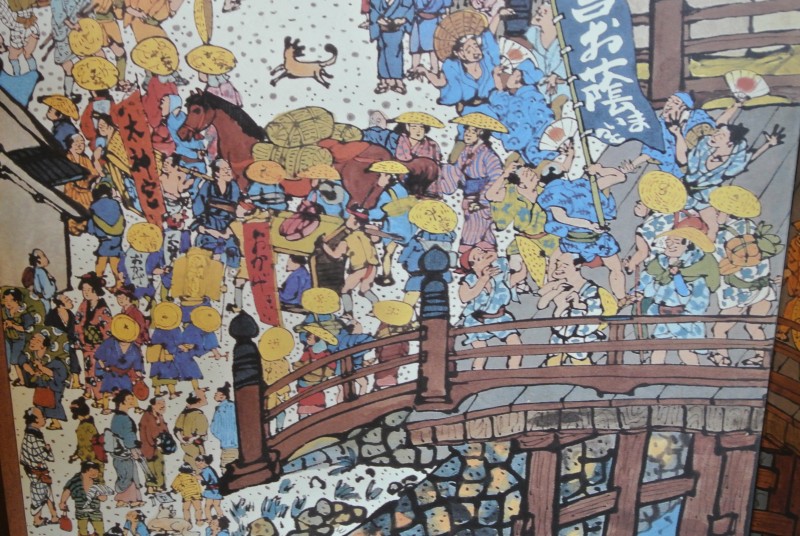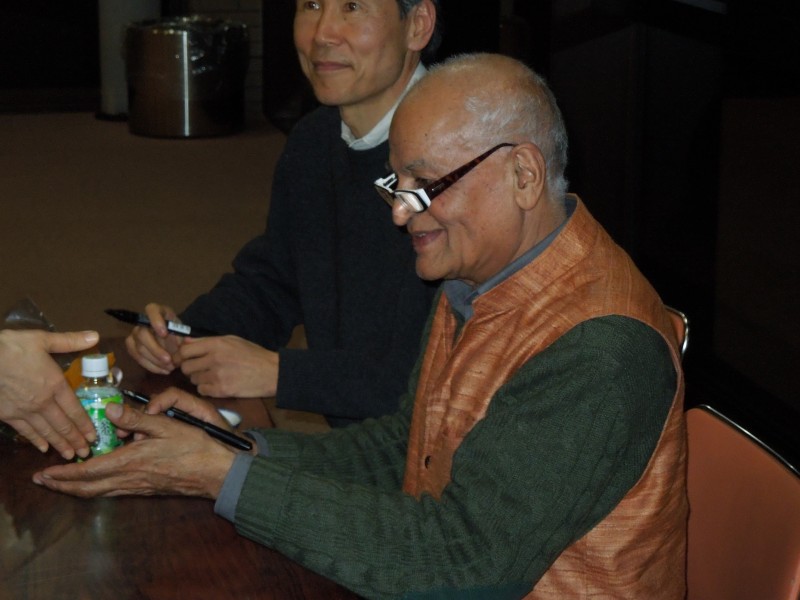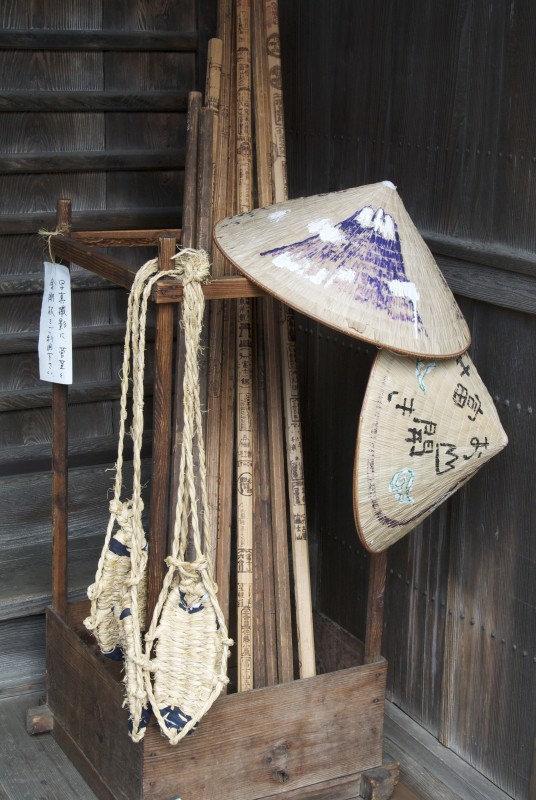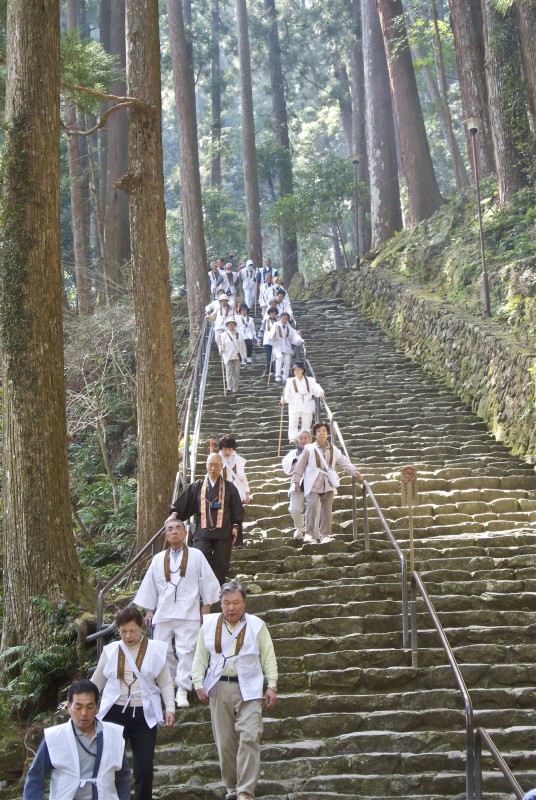
In Edo times the pilgrimage to Ise was a bustling, jostling affair that mixed the secular and the spiritual
It seems wherever you go in Japan, there is a pilgrimage route nearby. Some of these are major pilgrimages, like that of the Kumano Kodo, while others are local and less well-known. There are 33 Kannon pilgrimages, Seven Lucky Deity pilgrimages, and miniature versions of the Shikoku 88 temple pilgrimage. Some have fallen into disuse, or are largely carried out these days by bus. Nonetheless the combination of movement, place and spirituality continues to have a powerful attraction, even in the modern age.
In the article below, the British environmentalist Satish Kumar writes of the many benefits of pilgrimage. He’s a remarkable figure, whom I’ve been lucky to meet on a couple of occasions. Once a Jain monk, he has campaigned for peace and nuclear disarmament, notably by walking over 8000 miles to the capitals of four nuclear countries – Washington, London, Paris and Moscow. He is editor of Resurgence, runs the Schumacher Collge of environmental studies in Devon, UK, and insists on reverence for nature as the basis for social and ethical action.
****************************
(Satish Kumar, extracted from an article in Kyoto Journal, no. 78)

Satish Kumar, earth pilgrim, at a talk in Kyoto two years ago
Being a pilgrim is a state of mind; it has nothing to do with actual travel. Travelling is symbolic. We travel in life, and through life. All of life is a journey. The journey is metaphorical as well as literal. Making a journey from A to B is only the ostensible goal. But going from A to B is not the point of the pilgrimage. Wherever you are, with your consciousness, with your way of being, with your way of looking at the world, with your way of connecting with the world, you are a pilgrim. A pilgrim is someone who sees life as a sacred journey, who sees the Earth as a sacred home, who sees the universe as a process.
When you are making a physical journey and living thanks to the hospitality of people along the route,you experience the generosity of your host and humility in yourself. That experience can linger even after the physical journey. So, the physical pilgrimage and the metaphorical pilgrimage are interrelated.We make the outer journey in order to make an inner journey. Our inner landscape is shaped by the outer landscape and viceversa.Therefore,by making a journey to holy places, such as the River Ganges, Mount Kailash, Santiago de Compostela or Iona, I was moved to explore my inner landscape, and make my journey to the holy source within. The abundance and the majesty of the Earth inspires me and lifts my spirits. Thus, the outer journey and the inner journey become one.
If you only want to get somewhere, then you are a tourist. A tourist looks for self-gratification. A pilgrim seeks to commune with the other and unite with the whole. For a pilgrim, every moment is a sacred moment, a beautiful moment; every moment is an opportunity to connect. Connecting and relating is true spirituality. Spirituality is present everywhere, in every moment, at every time. Just as there is no moment when we are not breathing, in the same way there is no moment when we are not spiritual.
To be a pilgrim is to be on a path of adventure, to move out of our old comfort zones of certainty and to learn to be comfortable with uncertainty, with surprises and with the unpredictable. We have to let go of our prejudices and preconditioning, to make strides towards the unknown. It is a natural human condition to be afraid of the unknown. But the holy grail is not a tourist destination! There are no guidebooks, there are no road-maps, you cannot book your accommodation in advance!
When we consciously become pilgrims, our journey becomes a hero’s journey. The mythologist Joseph Campbell talked about this journey. Heroes are those who are prepared to take their lives in their hands. They are not afraid of risks. They are not self-centred, because they are totally and unreservedly dedicated to their quest. The Buddha was a hero of this kind. He left behind his princely palace, his wife and child, his wealth and comfort, his servants and courtiers. He moved out of his comfort zone, seeking the end of human suffering. He did not contemplate for a moment the impossibility of the task. The innocence of his mind was such that he was prepared to go through any difficulties, any problems, any obstacles, to fulfil his quest.
In essence I realised that being a pilgrim is a state of mind, a state of consciousness, a state of fearlessness.



Your timing is impeccable John. Satish Kumar’s words make a lot of sense in the context of my recent experiences in Japan. I was just reading about the Kumano Kodo after visiting a Kumano Shrine in Yokohama, as well as reading about the Seven Lucky Gods pilgrimage routes in Shinagawa City after visiting a shrine dedicated to Daikokuten there. Now I must concentrate on some writing. After that’s done there will be time to plan some serious walking.
Writing and walking – both things which are well worth doing. Or indeed writing about walking. I will be visiting Japan as soon as I can for some pilgrim walking and paying of respects to the genii loci if they exist and are worthwhile. Shikoku may be too commonplace for the initiates and aficionados but still sounds good to me.
All very well and true to say all of life is a pilgrimage but you can’t beat the real thing. Moving cultures but keeping to the theme, check out a little drawing by Kaspar David Friedrich of a room with an open window (as I recall) with a pilgrim’s staff leaning against a wall. Visions of escape and freedom and even if there is no escape really from the mundane, the quotidian and the grindingly mediocre (as well as much worse of course), such visions (and realising them) work well as simulacra.
Good day, Phinella, and thank you for writing in… Shikoku is well worth visiting, and I do hope you’ll be able to write in afterwards and give us your impressions. As Basho said, ‘Each day is a journey and the journey itself home’.